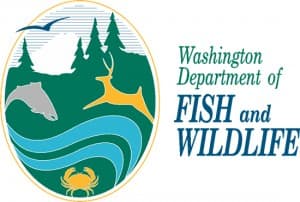Washington DFW Removes Wolf From NE Washington Pack After Livestock Attacks
OutdoorHub 08.07.12

State wildlife managers today killed a wolf from a pack that has repeatedly preyed on livestock in a remote area of northeast Washington for the past five years.
Acting under the terms of the state’s 2011 Wolf Conservation and Management Plan, the Department of Fish and Wildlife (WDFW) took lethal action after a series of wolf attacks on the Diamond M herd, whose owners graze about 400 head of cattle in an area known as the Wedge near the Canadian border. The attacks left one calf dead, five cows or calves injured and at least two missing since mid-July.
The wolf removed today was identified as a non-breeding female member of the Wedge pack. It was shot this morning by department staff in the area where an attack on livestock had occurred in July. Department staff planned to remain in the area through Wednesday afternoon in an attempt to remove a second wolf.
WDFW Director Phil Anderson said the decision to take lethal action was made only after the department determined that the action would not adversely affect wolf recovery objectives.
He also said the department had tried a variety of non-lethal efforts to protect livestock from attacks by the Wedge pack. Efforts included using specialized electric fencing to protect calves this spring; attaching a radio collar to the pack’s alpha male; and maintaining a regular human presence in the area.
In addition, the livestock operator employs five cowboys to frequently check on the herd, which consists of 210 cow-calf pairs.
“These ranchers live and work in an area with the highest concentration of wolves in the state,” said Anderson, who had visited the Diamond M ranch following wolf attacks on livestock in July. “The wolf plan is designed to support the recovery of wolves, but it also outlines specific strategies to minimize livestock losses.”
The plan, approved last December by the Washington Fish and Wildlife Commission after five years of public involvement, specifically authorizes WDFW to take lethal measures to address repeated attacks on livestock. The plan states that when lethal removal is necessary, one or two wolves may be removed initially.
Several wolf-related incidents have been documented in the range of the Wedge pack, including:
- In 2007, wolves killed two calves from the Diamond M herd.
- Since then, livestock operators have reported wolf presence in the area and higher-than-normal calf losses.
- Earlier this year, WDFW documented wolf activity around a calving operation.
- In July, wolves killed one calf and injured a cow and another calf. Later, two other injured calves were found and confirmed to have been attacked by wolves. The rancher also observed two additional injured calves but was not able to capture them.
- Last week, a calf was found with a laceration and bite mark that wildlife managers determined were the result of a wolf attack.
“Our goal in taking today’s action was to reduce the size of the pack and break the pattern of predation,” said Nate Pamplin, assistant WDFW wildlife director. “We can’t guarantee that today’s action will prevent future attacks by this pack, but we have clear indications that non-lethal actions alone are unlikely to reduce predation on livestock.”
Pamplin said the WDFW staff would remain in the area through Wednesday morning in an attempt to remove a second wolf. He said the department would re-evaluate its options later this week.
Gray wolves are classified as “endangered” under Washington state law, but are no longer protected in the eastern third of the state under the federal Endangered Species Act. The state’s wolf plan sets population recovery objectives and outlines methods for minimizing wolf-livestock conflicts.
As of July, wildlife biologists had confirmed eight wolf packs within the state and suspect there are four additional packs based on public reports and observed tracks. The number of confirmed packs represents an increase from two in 2010, indicating that the wolf population is rebounding, which also increases the potential for wolf-livestock conflict.
“Parts of northeast Washington are extremely rugged and remote, and the region borders areas of Idaho and Canada that already support large numbers of wolves, so it’s not surprising that wolves have re-established themselves more quickly here than in other parts of the state,” Anderson said. “But our wolf recovery strategy is a statewide plan that also permits us to minimize wolf-livestock conflict that could undermine public support for the long-term recovery effort.”

